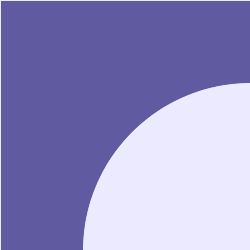| CPSC 120 |
Principles of Computer Science |
Fall 2024 |
Lab 4
Modularity and Abstraction
Due: Fri 9/27 at the start of lab
Labs are due at the start of lab. It is OK if you
show up to lab and copy your files to the handin directory at the very
beginning of lab, but this should take at most a couple of minutes and
you should not spend the next lab period finishing up the previous
week's lab. I will check timestamps, and files handed in more than
five minutes after the start of lab will be considered late.
See
the policy on late work and
extensions.
Introduction
This week's lab deals with functions, an important tool
for modularity and reuse. Declaring a function
bundles a series of related instructions (such as the instructions
to draw a complex shape) into one package distinct from the rest of
the program, and adding parameters allows the same basic steps to be
reused with different values without having to rewrite the steps
themselves. Both of these aspects of functions become increasingly
important as programs get larger and more complex.
Several of the exercises are based on traditional quilt
patterns. These kinds of quilts are an excellent real-world example
of modularity and abstraction — first individual pieces of
fabric are assembled into blocks, then the blocks are assembled to
create the whole quilt.
Successfully completing this lab means that you are able to:
- write syntatically correct function definitions and calls, for
functions with and without parameters
- identify when drawing functions are appropriate, and what
parameters are needed
- leverage the power of abstraction to create complex scenes more
easily
- choose appropriate names for functions and parameters
- write descriptive comments for functions
Academic Integrity and Collaboration
Labs are a
chance to practice and gain understanding. You may get help in
office hours, at Teaching Fellows, and from other students and may
use other materials (such as reference books or websites) but the
course materials (including provided links or references to
documentation and other materials) along with office hours and the
Teaching Fellows should be your primary resources. Always start
with these!
You must document any help received and any outside resources used.
Be careful not to rely too much on others — things often
look easy (or at least easier) when someone else does it. (You
don't want the exam to be where you discover this!) You should
always make the first attempt at doing something yourself, and
make sure that you always fully understand the help you received
— you should be able to explain your solution to someone
else, and should never just write down code that someone else
wrote or told you to write without be able to explain what it
does and why.
Also remember that the goal of the exercises and of this course is learning
the process of creating programs, and that what you hand in for
a grade is a reflection of your engagement of that process.
When you get help, also ask about that process
— if you're stuck on what to do next, ask not only what to do
next but also how one knows that's what to do, or if your program
isn't working correctly, ask not only what's wrong and how to fix it
but also how to track down the problem for yourself.
You may not shortcut to a solution by copying code (except
as specifically authorized in instructions) or working with others to
write code together. You may not be in possession of someone
else's program or solution before you have handed in your own. See
the full collaboration policy
for more on this.
Handin
To hand in your work:
-
Make sure that your name and a short description of the
sketch are included in a comment at the beginning of each
sketch.
-
Make sure that you've auto-formatted each sketch.
-
Copy the entire lab4a, lab4b, and lab4c
directories from your sketchbook
(~/cs120/sketchbook) to your handin directory (found
inside /classes/cs120/handin).
Preliminaries
Getting Started
Before you start writing code, remind yourself of:
- the purpose of function definitions and calls, and what each is
- the structure of function definitions and calls
- the function questions, and how the answers to those questions
fill in the pieces for defining and calling functions
All of these things have been covered in class, and the slides and
in-class exercises handouts posted on the schedule page are the places
to find this information. It is also a good idea to review the
examples from class and make sure you understand the role of each line
of code in the sketch — what does it do? Why is it there? How
does it relate to the patterns for function definitions and class (as
well as the previous topics of sketch structure, variables, and
animation)?
Keep incremental development in mind — even though the
exercises list the "create drawing function(s)" step before the
"complete the sketch" step, you can still apply incremental
development. Start with a simple function body — draw just one
of the shapes you'll need, for example — and make one call to
the function from draw(). Gradually build up the body of the
function; once it draws the complete pattern, add a second call to it
in draw() (and so on). You can also start without parameters
— have the function draw the shape in a fixed spot — and
then add parameters once you have that working.
Also remember how to work out coordinates — draw pictures and
label what you know! This is especially important when variables and
parameters are involved because you need to work out expressions to
calculate positions and sizes rather than just figuring out the
correct number.
Notes on Functions
-
Comment function definitions. Each function should
have a comment immediately before it describing the function's purpose
(what does it draw?) and each of its parameters. For example:
// draw a snowman
// (x,y) is position of the bottom center
void drawSnowman ( int x, int y ) {
...
}
-
Functions should have one (and only one) purpose. A
drawing function draws something — it should contain all of the
statements necessary for drawing that something, but only statements
actually for drawing that something — it should not contain
statements for drawing other things or statements not for drawing. In
particular, updating animation variables is not drawing and should go
in draw(), not one of your drawing functions.
-
Avoid having more parameters than necessary. For
example, a single parameter for the size of a square or circle is
sufficient — you don't need separate width and height parameters
because the width is always the same as the height for those
shapes.
Integer Division
Let's say that width is 600 — what is the value
of 2/3*width? You expect it to be 400, but this expression
actually evaluates to 0! This is because the division
operator / works differently depending on the type of its
operands. When used with floats, as in 2.0/3.0
the result is as expected — 2.0/3.0 = 0.66667. But when
used with ints, the result is the number of whole times the
denominator divides the numerator — 3/2 = 1, 600/140 =
4, and 2/3 = 0. (Another way to think about it is
that integer division does the division but then drops the decimal
part e.g. 3/2 = 1.5, which is 1 when the 0.5 is
dropped.)
To avoid surprises, here are two guidelines:
-
If you want the result to be an integer, write the
expression so the multiplication(s) happen first
e.g. 2/3*width can be rewritten as 2*width/3.
This still results in integer division, but the result is no
longer 0 — 2*width happens first, then 1200/3 =
400.
-
If you want the result to have a decimal point,
introduce floats in the numerator and/or denominator of
the division. For example, rewrite 2/3*width
as 2.0/3.0*width. Now the result is 400.0,
because 0.67*600 = 400.0. If only integer variables
are involved (e.g. width/height), multiply either the
numerator or denominator by 1.0: (1.0*width)/height.
(The parens ensure that the multiplication happens before the
division.)
Exercises
Put your name and a description of the sketch in comments at the
beginning of each sketch. Also don't forget to Auto Format your code
before handing it in. (Refer back to lab 2 for more on Auto Format if
needed.)
Exercise 1
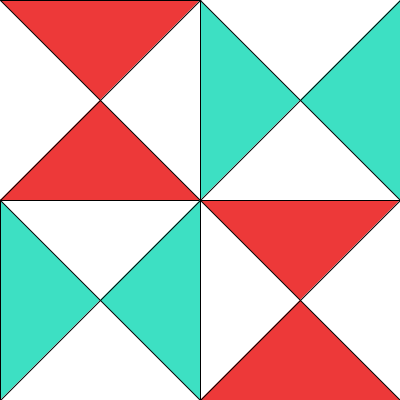
The goal in this exercise is to create a sketch
named lab4a which draws the hourglass quilt shown.
To create this sketch:
-
Create a new sketch, add your name and a description of the
sketch in comments at the beginning, and save your sketch
as lab4a.
-
Copy and paste or type the following into your sketch, then
run it to see what it does.
void setup () {
size(400, 400);
}
void draw () {
background(255);
// vertical block
stroke(0);
fill(237, 57, 57);
triangle(0, 0, 200, 0, 100, 100);
triangle(0, 200, 100, 100, 200, 200);
// horizontal block
stroke(0);
fill(61, 224, 195);
triangle(200, 0, 300, 100, 200, 200);
triangle(400, 0, 300, 100, 400, 200);
}
-
Define functions drawVerticalBlock
and drawHorizontalBlock to draw the vertical (red) and
horizontal (green) variations of the hourglass block. Move the
drawing code for each block from draw to the body of
the appropriate function, and call the functions
from draw. Also include comments for each function.
Run the sketch to make sure it still works
the same as it did.
-
Add parameters to the drawVerticalBlock function so
that the block can be drawn in any position and update the body
the function to utilize those parameters. Also update the
function comments and call accordingly. Run the sketch to make
sure it still works the same as it did.
-
Add a second call drawVerticalBlock to draw the other
vertical (red) block. Also include comments for each function.
Run the sketch to make sure the second block is positioned
correctly.
-
Repeat the previous two steps with
the drawHorizontalBlock function — add parameters for
the position, updating the body and call accordingly, and then add a
second call to complete the quilt pattern.
Exercise 2
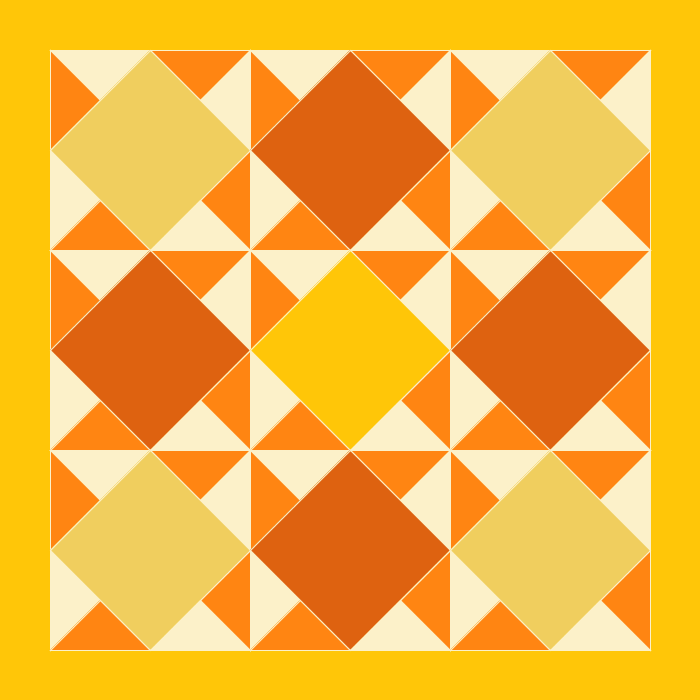
The goal in this exercise is to create a sketch
named lab4b which draws the quilt shown.
To create this sketch:
-
Create a new sketch, add your name and a description of the
sketch in comments at the beginning, and save your sketch
as lab4b.
-
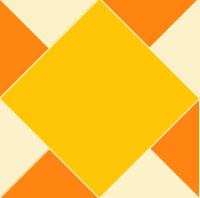
Write a function drawBlock which draws the quilt block
pattern shown. It should have parameters for the position and size of
the block (the block will always be a square, so you only need a
single parameter for the size and not separate parameters for width and
height) and the color of the center diamond shape. (You can choose
the two colors to use for the triangles — you do not need to match the
colors shown, but you should match the pattern so that things that are
the same color in the example are the same color in your block.) Use
a quad (look it up in
the Processing API to
see how to use it) to draw the center diamond shape. Include comments
describing the function and its parameters.
Test your function by calling it from draw.
-

Complete the sketch to produce a quilt similar to the one shown
using your drawBlock function. You can choose whatever
colors you want, but the pattern should match (three different center
diamond colors, and things with the same color in the picture have the
same color in your sketch) and the blocks must be arranged in a 3x3
grid with a border around the outside of the quilt.
Exercise 3
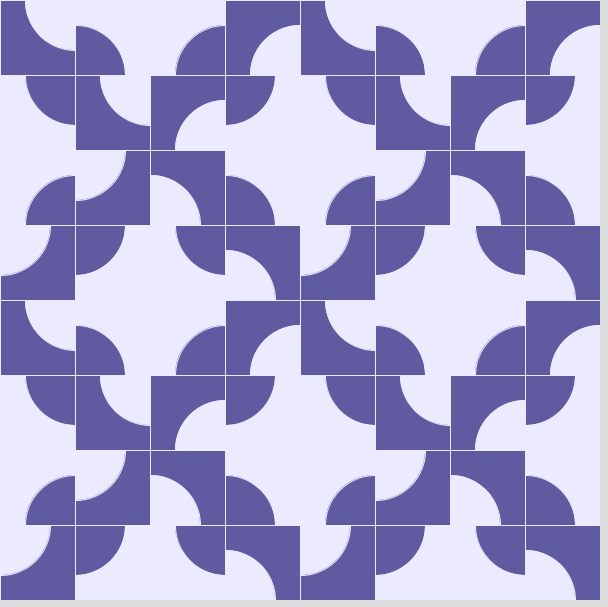
The goal in this exercise is to create a sketch
named lab4c which draws the quilt shown. (This is a
traditional pattern known as Drunkard's Path.)
To create this sketch:
-
Create a new sketch, add your name and a description of the
sketch in comments at the beginning, and save your sketch
as lab4c.
-
Write four
functions drawDrunkardUR, drawDrunkardUL,
drawDrunkardLR, and drawDrunkardLL to draw the four
patterns shown. (The naming scheme indicates where the arc is — UR for
upper right, LL for lower left, etc.) Each function should take the
position and size of the pattern and the two colors used as
parameters. (Assume that the block will always fill a square
region, so only one parameter is needed for the size.) Note that the
radius of the arc is two-thirds the size of the rectangle. Include
comments describing each function and its parameters.
Test your functions by calling them from draw.
-
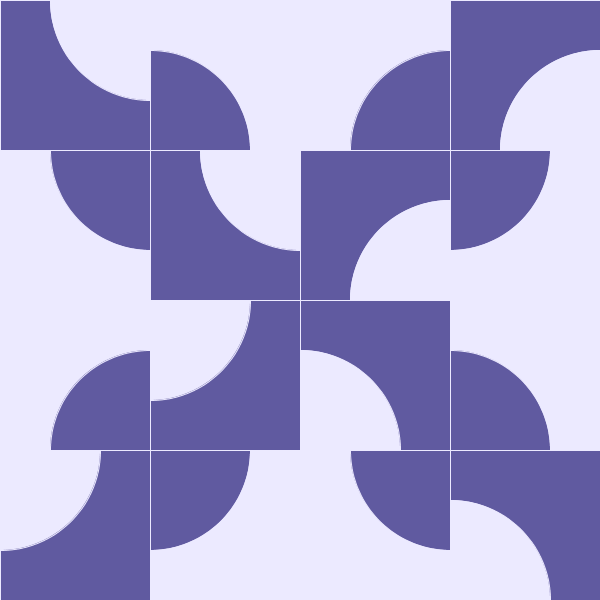
Write a function drawDrunkardBlock which takes the
position, the size (again assume that it will always be a square), and
two colors as parameters and draws the block shown. Use the functions
you wrote in the previous step to draw each of the 16 pattern squares
— don't draw rectangles and arcs directly
in drawDrunkardBlock! Include comments describing the
function and its parameters.
Test your function by calling it from draw.
-

Complete the sketch to produce a quilt similar to the one shown
using your drawDrunkardBlock function. (The blocks are
arranged in a 2x2 grid.) You can choose whatever colors you want.
Exercise 4
Create a sketch of your own design. (Name this
sketch lab4d.) What the sketch depicts is up to you
(here's a chance to be creative!) but for full credit it must
include the following required elements:
-
The scene must be original and created by you for this
exercise. While you might be inspired by an example from class
(such as the simple car) or another exercise in this (or a
previous) lab, you may not copy code from other exercises in
this lab or other labs, examples or solutions in the textbook
or from class, or other sources even if you then make some
changes — create your own version (such as a fancier
car) from scratch.
-
The scene must be recognizable as something. The intent is
that you should deliberately choose positions and colors for the
shapes — simply drawing a bunch of shapes at whatever location they
happen to end up at is not acceptable. Simplifying things (like
making a tree out of a rectangle and a triangle) is fine.
-
You must use at least 30 shapes. (That's 30 shape-drawing
commands, not 30 different kinds of shapes. Note that a function which
draws five shapes only contributes five shapes to the total even if
the function is called multiple times — this is a count of different
statements that you write to draw shapes, not how many shapes appear
on the screen.)
-
You must have at least four different compound things built
out of three or more shapes each, with a function to draw each kind of
thing. For example, if you have a car and a (three-shape) tree and a
snowman in your scene, you must create a car-drawing function, a
tree-drawing function, and a snowman-drawing function.
-
You must demonstrate variation in position, size, and color
using functions with parameters. This means that you'll need multiple
instances of at least one of your compound things and will need to add
parameters to at least one of your drawing functions as a result —
your sketch might contain two otherwise-identical cars in different
positions, for example, and thus should have a single car-drawing
function with parameters for the position rather than separate drawing
functions for each car. The three properties (position, size, and
color) can be covered together or in other combinations — a red car, a
blue car, a large snowman, and a small snowman all in different
positions covers all three properties, as does just a large red car
and a small blue car in different positions.
-
Each function must have a descriptive name related to its
purpose (e.g. drawTree would be a good name for a
tree-drawing function) and a comment immediately before the function
describing the purpose of the function and what each of its parameters
are for. For example:
// draw a tree
// (x,y) is the position of the bottom center of the tree trunk
void drawTree ( int x, int y ) {
...
}
-
At least two instances of one of the compound things must be
interactive and/or animated in different ways. For example, two
cars could each move in different directions and at different
speeds, or one car could move while another changes color, or one
car could be animated in some way while the other tracks the
mouse, or one car follows the mouse's x coordinate while another
follows the mouse's y coordinate. Note: do not
use mouseX, mouseY, or animation variables in
the body of your drawing functions! Instead, add parameters for
whatever is changing and pass in the desired value. For example,
to have a tree that follows the mouse around,
define drawTree with parameters for the position:
void drawTree ( int x, int y ) {
...
}
and then call it with drawTree(mouseX,mouseY).
(It is legal to use mouseX, mouseY, and
animation variables inside function bodies, but it is better
programming style in many cases not to.)
-
As with all sketches, your name and a description of what your
scene is a picture of must be included in a comment at the beginning
of the sketch and your code must be properly formatted. (Use
auto-format!)
Extra Credit
You can earn extra credit by going substantially beyond the required
elements. Add to your sketch for #4 and include a brief description
of what you've done for extra credit in a comment at the beginning of
your sketch. Some possibilities:
-
Lots more stuff — more shapes, more more compound shapes
(drawn with parameterized functions).
-
Build up more complex shapes by creating drawing functions
which call other drawing functions (as in #3). Incorporate some
additional complexity — functions which call functions which
call functions (etc) or animated elements (such as a windmill with
rotating blades).
-
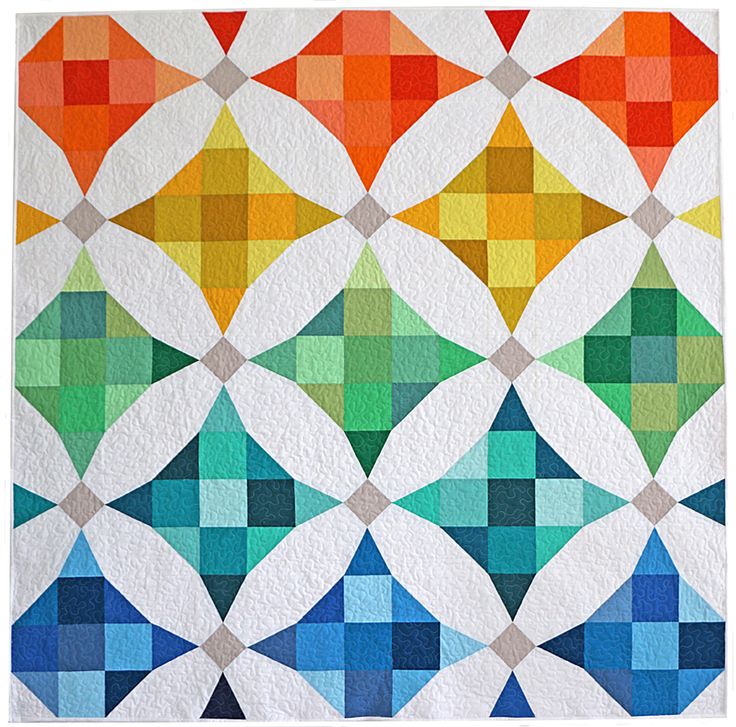
Draw a quilt like the one shown as an element in or as the background
for your scene. Make use of parameterized functions to save work!
(Very little credit will be given if you just draw lots of individual
rectangles and triangles, or if you have lots of very similar
functions when a single parameterized one would do.) A clever way to
handle the color variations would be to add/subtract small random
amounts to the components of a base color. (Look up random()
in the Processing
API.) To avoid flickering effects when random() is used
in active mode, put the statement
randomSeed(0);
at the beginning
of draw().
More creative and
challenging elements will earn more points.






